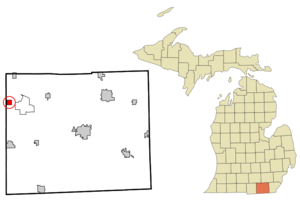- Addison, Michigan
Infobox Settlement
official_name = Addison, Michigan
settlement_type = Village
nickname =
motto =
imagesize =
image_caption =
image_
imagesize =
image_caption =
image_
mapsize = 250px
map_caption = Location of Addison in Lenawee County, Michigan
mapsize1 =
map_caption1 =subdivision_type = Country
subdivision_name =United States
subdivision_type1 = State
subdivision_name1 =Michigan
subdivision_type2 = County
subdivision_name2 = Lenaweegovernment_footnotes =
government_type =
leader_title =
leader_name =
leader_title1 =
leader_name1 =
established_title =
established_date =area_footnotes =
area_magnitude =
area_total_km2 = 2.6
area_land_km2 = 2.5
area_water_km2 = 0.1
area_total_sq_mi = 1.0
area_land_sq_mi = 1.0
area_water_sq_mi = 0.0population_as_of = 2000
population_footnotes =
population_total = 627
population_density_km2 = 248.1
population_density_sq_mi = 642.6timezone = Eastern (EST)
utc_offset = -5
timezone_DST = EDT
utc_offset_DST = -4
elevation_footnotes =
elevation_m = 325
elevation_ft = 1066
latd = 41 |latm = 59 |lats = 14 |latNS = N
longd = 84 |longm = 20 |longs = 45 |longEW = Wpostal_code_type =
ZIP code
postal_code = 49220
area_code = 517
blank_name = FIPS code
blank_info = 26-00380GR|2
blank1_name = GNIS feature ID
blank1_info = 0619840 [gnis|0619840]
website =
footnotes =Addison is a village in Lenawee County of the
U.S. state ofMichigan . As of the 2000 census, the village population was 627. The village is located on the boundary between Rollin Township on the south and Woodstock Township on the north.Geography
According to the
United States Census Bureau , the village has a total area of 1.0square mile s (2.6km² ), of which, 1.0 square miles (2.5 km²) of it is land and 0.04 square miles (0.1 km²) of it (2.97%) is water. most of the population is in the down town part of addison.History
In 1834, when John Talbot settled along a winding creek in the infancy of southeast Michigan’s history, the area was a vast forest, dotted with clear blue lakes and occupied by the Potawatomi. With the raising of a simple grist mill along Bean Creek around December 1835, Addison’s history was started, operating under the settlement name “Manetue”.
Having failed to secure a spot along the river that provided enough water power to run his mill, Talbot dismantled the settlement and moved to the present location of Addison, and by the fall of 1836, milling operations restarted. The town was renamed “Peru” by 1838, and over the next generation would be given several other monikers before the final name of Addison was entered onto
plat maps in 1851. Addison J. Comstock, a banker fromAdrian, Michigan , purchased a sizable plat of the pioneer town and changed the identity to reflect this acquisition. The village itself was incorporated as such in 1893.The village grew sufficiently to attract the railroad in 1883, an event which contributed to a sudden expanse of Addison’s local economy. Businesses came to Addison in great numbers, as well as a three-story hotel, designed to cater to the visiting tourist.
The Addison Courier newspaper started its 76-year run in 1884, and the economic upturn brought on by the railroad continued well after the line ceased to operate through Addison.One of Addison’s last landmarks, the old grist mill built in 1848, was removed in 1980. Despite the economic downturn of the village in the last half of the 20th century, a large 3-day sesquicentennial celebration was held in 1984.
Today, Addison is a quiet burg, comparable to the size it was in the 1860s. Around two-dozen businesses and institutions occupy the town limits. The
Addison Community Schools campus is presently the largest property holder in Addison.In 1976, a small booklet on the town history was assembled by Addison historian Alice Slocum, followed in 1997 by a 225 page illustrated book by local author Dan Cherry. A followup companion volume is in the works and is expected to be released later in 2008.
Demographics
As of the
census GR|2 of 2000, there were 627 people, 247 households, and 164 families residing in the village. Thepopulation density was 642.6 per square mile (247.0/km²). There were 265 housing units at an average density of 271.6/sq mi (104.4/km²). The racial makeup of the village was 98.41% White, 0.16% Native American, 0.96% Asian, 0.16% from other races, and 0.32% from two or more races. Hispanic or Latino of any race were 2.07% of the population.There were 247 households out of which 35.2% had children under the age of 18 living with them, 50.2% were married couples living together, 13.8% had a female householder with no husband present, and 33.2% were non-families. 29.6% of all households were made up of individuals and 10.5% had someone living alone who was 65 years of age or older. The average household size was 2.54 and the average family size was 3.17.
In the village the population was spread out with 31.1% under the age of 18, 9.7% from 18 to 24, 28.2% from 25 to 44, 19.6% from 45 to 64, and 11.3% who were 65 years of age or older. The median age was 35 years. For every 100 females there were 94.7 males. For every 100 females age 18 and over, there were 87.8 males.
The median income for a household in the village was $35,781, and the median income for a family was $45,313. Males had a median income of $31,875 versus $23,000 for females. The
per capita income for the village was $15,883. About 6.0% of families and 8.1% of the population were below thepoverty line , including 7.2% of those under age 18 and 7.8% of those age 65 or over.Ancestry
The top 10 ancestry reported during the U.S. census
Transportation
Major highways
References
External links
* [http://www.lenawee.mi.us/ Lenawee County government site]
* [http://www.lenaweehistory.com/ Complete text of "History of Lenawee County" published in 1909 by the Western Historical Society]
* [http://scnc.addison.k12.mi.us/index.html/ Addison Community Schools web site]
Wikimedia Foundation. 2010.


